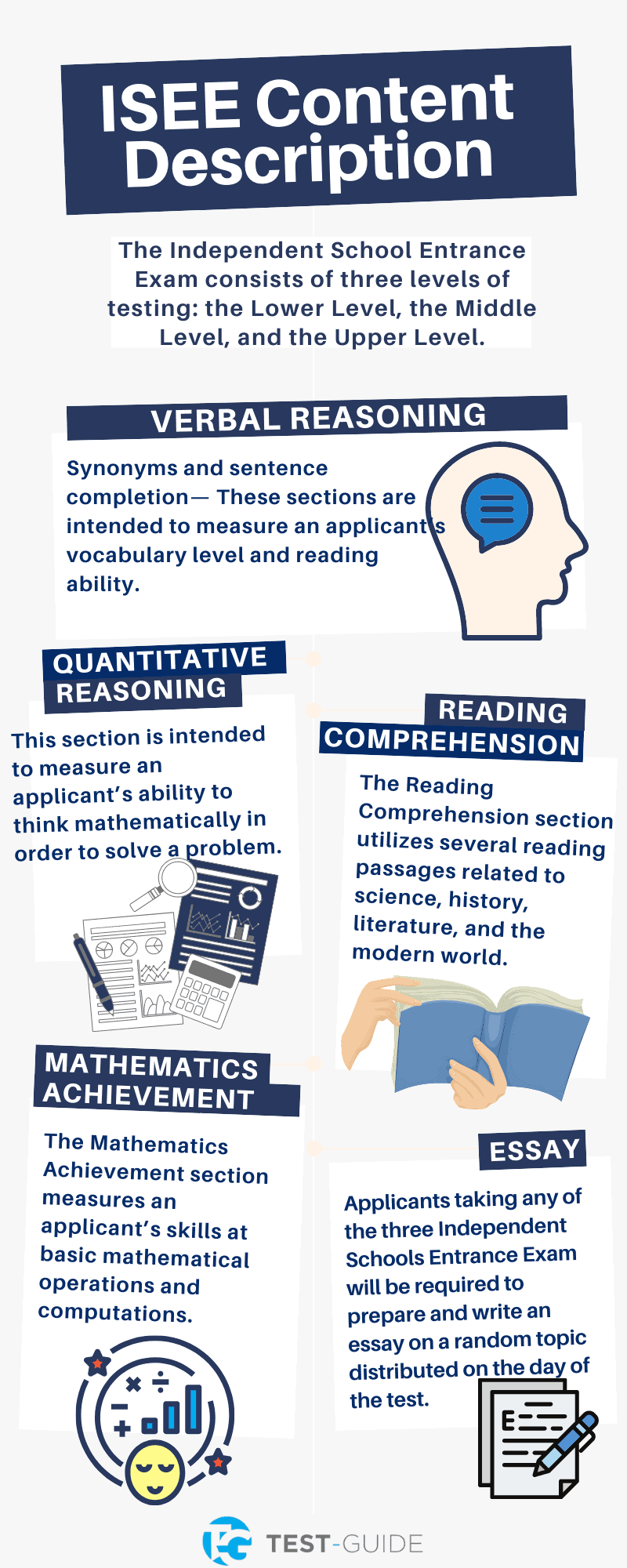The Independent School Entrance Exam (“The ISEE”) is an admission assessment utilized by admission specialists at over 1,200 independent schools around the world. It is available both online and in paper form, and measures basic math, reading, and verbal reasoning skills.
The ISEE provides administrators with a fair and reliable test in order to assess applicants in an unbiased way.
An applicant’s performance on the ISEE can often be an important factor in that applicant’s admission to an independent school.
ISEE practice tests as well as other resources are available for students who may be required to take it. Utilization of these resources can be vital for those who want to perform well on the ISEE.
Free ISEE Practice Tests
ISEE Verbal Reasoning (Upper Level)
ISEE Quantitative Reasoning (Upper Level)
ISEE Reading Comprehension (Upper Level)
ISEE Mathematics Achievement (Upper Level)
Recommended ISEE Prep
If you are serious about doing well on your ISEE, check out our recommended ISEE prep course.

Other ISEE Study Resources
| Resource | Notes | Provider |
| ISEE Upper Level Flashcards | Review 600+ upper level flashcards. | Quizlet |
| ISEE Middle Level Flashcards | Review 200+ middle level flashcards. | Quizlet |
| ISEE Lower Level Flashcards | Review 200+ lower level flashcards. | Quizlet |
ISEE Content Description
The Independent School Entrance Exam consists of three levels of testing: the Lower Level, the Middle Level, and the Upper Level. These levels are based on whatever level of schooling the student has achieved upon applying to a particular independent school.
- Students entering grades 5 or 6 will take the Lower Level ISEE
- Students entering grades 7-8 will take the Middle Level ISEE
- Students grades 9-12 will take the Upper Level ISEE
Be sure you are using the appropriate ISEE practice tests for your particular level.
Each test is split up into five sections:

Verbal Reasoning
The Verbal Reasoning section includes a section for synonyms and a section for sentence completion These sections are intended to measure an applicant’s vocabulary level and reading ability.
- Each vocabulary question includes an appropriately abstract grade-level word which is followed by four answer choices.
- Each sentence completion question includes a sentence with a missing word or phrase, followed by four ways the applicant may choose to complete the missing part. The student must determine which selection best completes the sentence based on context.
Lower Level:
- This section consists of 34 questions to be answered in 20 minutes
Middle and Upper Levels:
- This section consists of 40 questions to be answered in 20 minutes
Quantitative Reasoning
The Quantitative Reasoning section measures the applicant’s reasoning abilities as they relate to various mathematical disciplines.
This section is intended to measure an applicant’s ability to think mathematically in order to solve a problem. Despite the mathematical content in this section, it requires very little or no actual calculations, as the emphasis of this section is on mathematical thinking and reasoning ability.
Questions are derived from the applicant’s grade-level appropriate National Council of Teachers of Mathematics (NCTM) Standards in the following skillsets:
- Numbers and Operations
- Algebra
- Geometry
- Measurement
- Data Analysis and Probability
- Problem Solving
Lower Level:
- This section consists of 37 word problems to be completed within 35 minutes
Middle and Upper Levels:
- This section consists of 37 questions to be completed within 35 minutes
- Questions are a mixture of word problems as well as quantitative comparisons
Reading Comprehension
The Reading Comprehension section utilizes several reading passages related to science, history, literature, and the modern world in order to assess an applicant’s reading comprehension in six specific categories:
- Main Idea– measures the applicant’s ability to identify the general message, theme, or central idea in the passage
- Supporting Ideas– measures the applicant’s ability to identify which concepts in the passage support the main idea of the text.
- Inference– measures the applicant’s ability to to draw a conclusion using content which is not explicitly stated in the passage. Inference questions may include:
- Analysis and interpretation of text
- Comparing and contrasting ideas
- Making predictions of events and outcomes
- Vocabulary– measures the applicant’s ability to use context clues in order to define words
- Organization and Logic– measures the applicant’s ability to identify the structure, pattern, or sequence present in a particular genre
- Tone, Style, and Figurative Language– measures the applicant’s ability to comprehend literary concepts such as:
- Point of view
- Mood
- Tone
Lower Level:
- This section consists of 25 questions to be answered in 25 minutes
- This section contains five reading passages with five questions each
Middle and Upper Levels:
- This section consists of 36 questions to be answered in 35 minutes
- This section contains six reading passages with six questions each
Mathematics Achievement
The Mathematics Achievement section measures an applicant’s skills at basic mathematical operations and computations, according to the applicant’s grade-level appropriate National Council of Teachers of Mathematics (NCTM) Standards.
Lower Level:
- This section consists of 30 questions to be answered in 30 minutes
Middle and Upper Levels:
- This section consists of 47 questions to be answered in 40 minutes
Essay
Applicants taking any of the three Independent Schools Entrance Exam will be required to prepare and write an essay on a random topic distributed on the day of the test.
- Upon receiving the topic, students are given 30 minutes to prepare and write their essay
- Students may use a blue or black pen
- Essay will not be graded, however the school to which the applicant has applied will receive a photocopy of the essay to assess in any way they wish
- Prompt will usually be relevant to the student and offer them an opportunity to tell about themselves
ISEE Administration
Independent Schools Entrance Exam test locations and dates can fluctuate, and are determined by the particular school administering the ISEE. Some states include:
- Connecticut
- Florida
- Massachusetts
- New York
- Pennsylvania
- Texas
As well as international locations including:
- Shanghai
- China
- Seoul, Korea
Applicants may also take their test through the use of a test consortium consisting of several area schools within a central location collaborating to test those applying to many different local independent schools. These consortiums can be found in most major US cities.
Registration for the ISEE Test
Students registering for the Independent Schools Entrance Exam can do so through the mail or at www.ISEEtest.org. Registering over the phone or via fax may include additional fees. It is important to register for your ISEE at least three weeks before your test date.
ISEE Test Fees
Registration for the Independent Schools Entrance Exam begins at $89, but can range up to $180 depending on location and accommodations needed. Registering over the phone or via fax will incur an additional $20 fee.
ISEE Requirements
The Independent School Entrance Exam can be taken by any student in grades 5-12 who is applying to enter an independent school. Requirement of completion of the ISEE is determined by the independent school being applied to.
ISEE Scores
Throughout all sections in all three versions of the ISEE, all questions are equal in value. The ISEE does not penalize for incorrect answers, so the raw score is solely determined by the number of correct answers given by the applicant. Test takers are encouraged to guess if they are not sure.
The ISEE score report includes both scaled scores and percentile scores:
Scaled Score
A conversion of the raw score, scaled between 760 and 940.
Percentile Score
The percentile score takes the scaled score achieved by the applicant, and ranks it from 1-99, based on the student’s performance compared to other test takers of the examination.
For example, if a student scored better than 90% of the students who took the same test, then that student’s Percentile Score would be 90.
- Shows how an applicant scored in comparison to other applicants of similar demographics.
- This is based on the norm pool of applicants which share the same grade as the applicant
- Schools receiving the ISEE score report and see how the applicant compares to the rest of the applicant pool
ISEE FAQS
What is on the ISEE test?
The ISEE is split up into five different sections – verbal reasoning, quantitative reasoning, reading comprehension, mathematics achievement, and an essay.
How much does it cost to take the ISEE?
The cost to take the ISEE varies, depending on location and different accommodations needed. The cost can range from $89 to $180. If you choose to register over the phone, it will cost you an extra $20.
Who takes the ISEE test?
Students who are in grades 5 and 6 will take the lower level ISEE. Students who are in grades 7 and 8 will take the middle level ISEE. Students who are in grades 9-12 will take the upper level ISEE.
Performance on the Independent Schools Entrance Exam is vital for admission to an independent school. To register for your ISEE, please visit erblearn.org to learn more.

